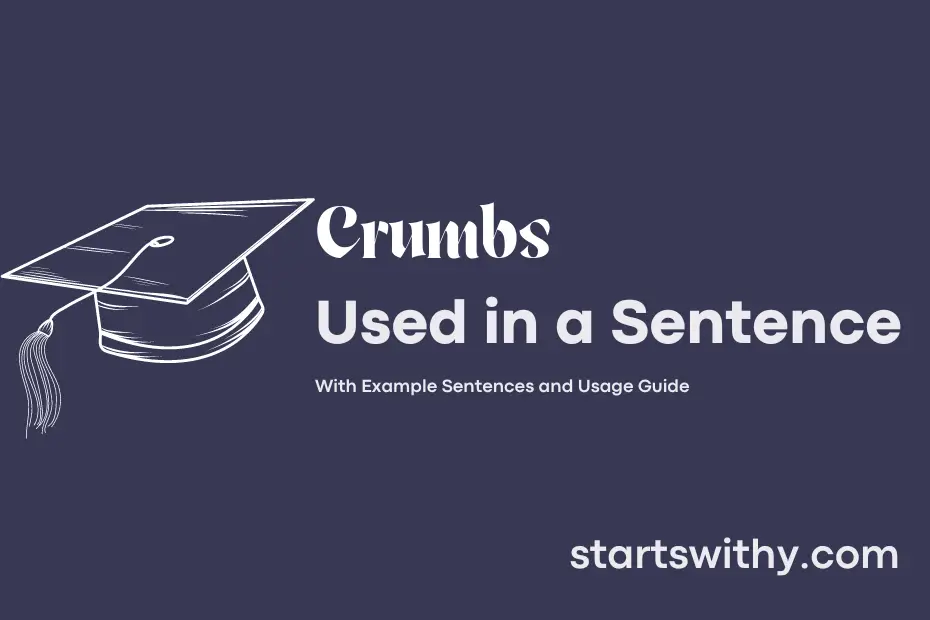Ever wondered how the tiniest details in a sentence, like “crumbs,” can make a huge difference in conveying meaning? Welcome to the world of syntax, where the arrangement of words shapes our understanding of language.
Syntax is the study of how words come together to form phrases, sentences, and beyond. Paying attention to syntax can reveal subtle nuances and idiosyncrasies that add layers of meaning to communication.
7 Examples Of Crumbs Used In a Sentence For Kids
- Crumbs are tiny pieces of food that we sometimes drop.
- I see some crumbs on the table after having snacks.
- Be careful not to make crumbs on the floor while eating.
- The ant trail led us to the crumbs left behind.
- Birds come to eat the crumbs we leave for them in the park.
- Let’s clean up the crumbs after we finish our meal.
- Sometimes, crumbs can attract insects if left on the ground.
14 Sentences with Crumbs Examples
- Crumbs were scattered all over the table after the late-night study session.
- I only had crumbs left in my wallet after buying all the textbooks for the semester.
- The cafeteria served such tiny portions that I was left with only crumbs for lunch.
- I found some crumbs on my bed after eating a snack while studying.
- My roommate always leaves crumbs on the floor after eating in our room.
- I gathered the crumbs from the bottom of my bag to snack on during the lecture.
- The library desk was covered in crumbs from students eating while studying.
- I accidentally spilled my bag of chips, leaving crumbs all over the common room.
- The ants were attracted to the crumbs left behind on the kitchen counter.
- I felt a bit embarrassed when my friend pointed out the crumbs on my face after eating.
- The hostel room was a mess, with crumbs scattered everywhere from last night’s party.
- I only had crumbs of information to go on for my assignment.
- The pigeon kept pecking at the crumbs scattered on the campus grounds.
- I reached into my pocket for a snack, only to find crumbs from the last time I ate on the go.
How To Use Crumbs in Sentences?
Crumbs can refer to small pieces of bread, cake, or crackers that are broken off or left over. In order to use the word Crumbs correctly in a sentence, it is important to consider its context and meaning.
For example, you can say, “She swept up the crumbs from the table after the meal.” In this sentence, crumbs is referring to the small bits of food that were left behind on the table.
Another example could be, “The crumbs were scattered all over the kitchen floor after the toddler’s snack time.” Here, crumbs are the tiny pieces of food that have been dropped or spilled.
You can also use Crumbs in a metaphorical sense, such as, “He was left with nothing but crumbs after his business failed.” In this case, crumbs are symbolic of small or insignificant remains.
Remember that Crumbs is both a singular and plural noun, so you can use it in a sentence with or without an “s” at the end, depending on the context.
With these examples and explanations in mind, you can confidently incorporate the word Crumbs into your everyday language and writing.
Conclusion
In conclusion, the examples of sentences with “crumbs” illustrate how this word can be used to describe small, leftover pieces of food or debris. From finding crumbs on the kitchen counter to using a broom to sweep up crumbs from the floor, this word is commonly associated with tiny fragments that may result from eating or breaking apart larger items. Whether it’s a simple sentence like “She swept up the crumbs from the table” or a more descriptive one such as “The trail of crumbs led them through the forest,” the versatility of this word allows it to convey different scenarios involving small, scattered particles.
Overall, the variations in the sentences presented demonstrate the adaptability of “crumbs” in depicting situations where small remnants are involved. Through these examples, it is evident that “crumbs” serves as a practical and descriptive term that effectively conveys the presence of scattered bits, whether in a literal sense related to food or in a metaphorical sense to describe a trail or trace.



